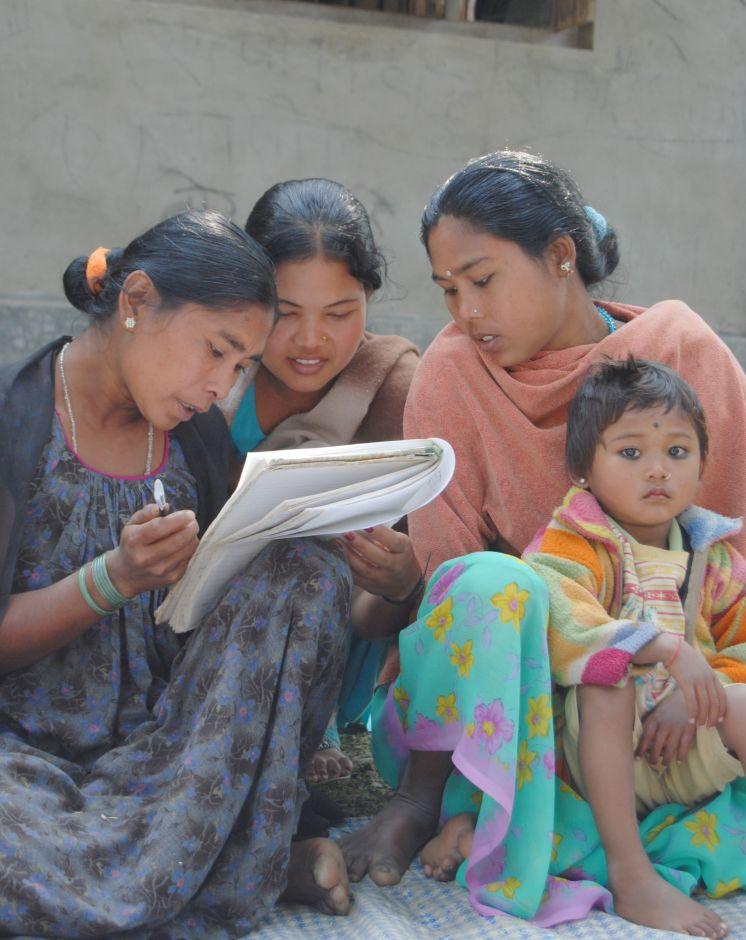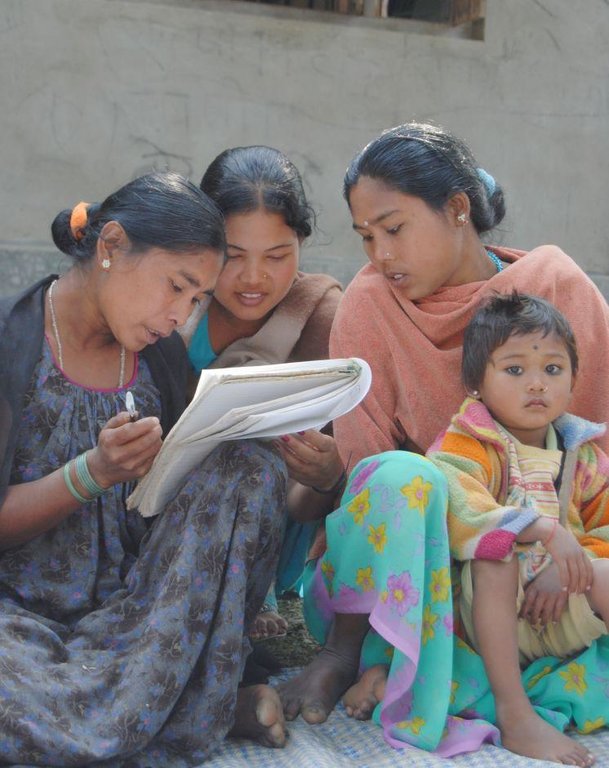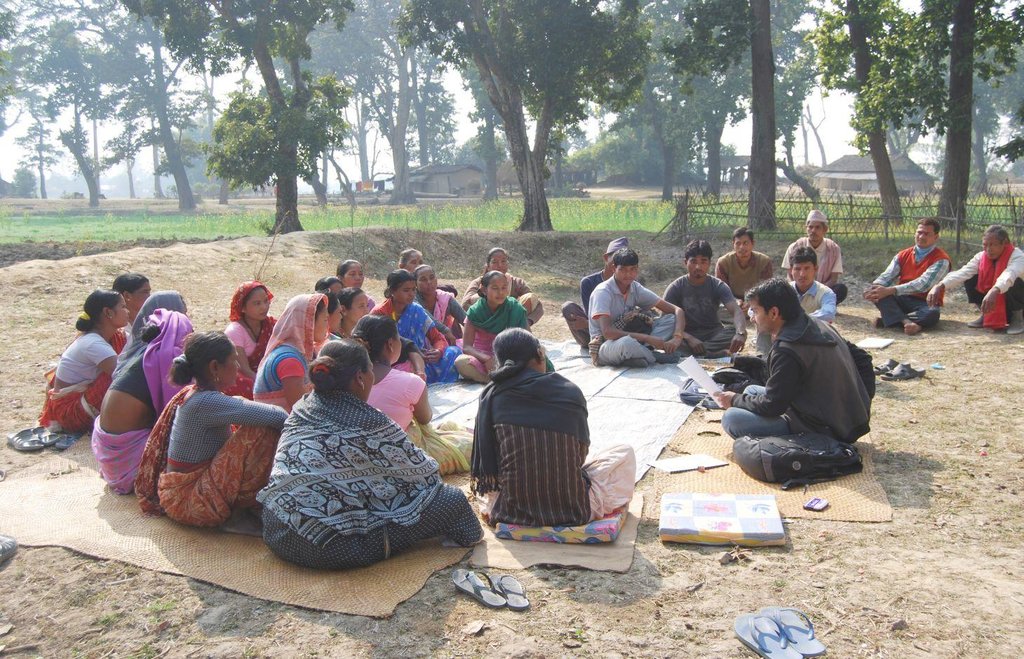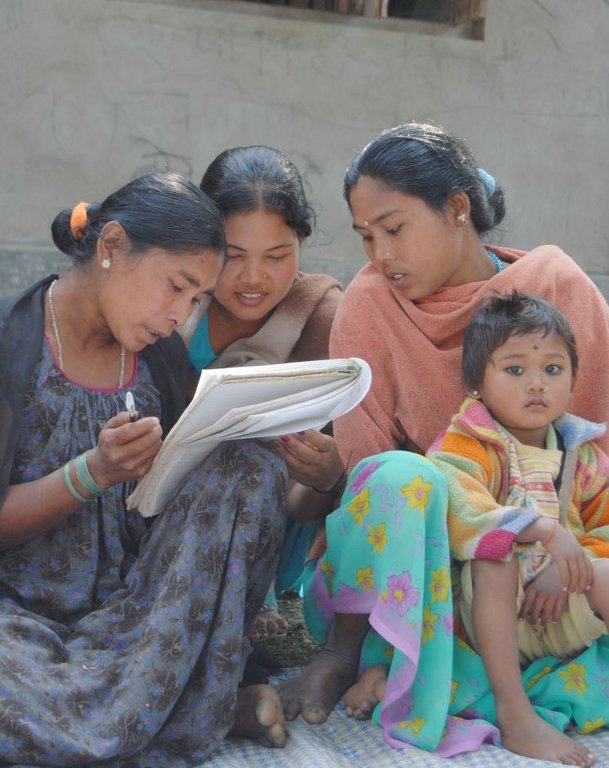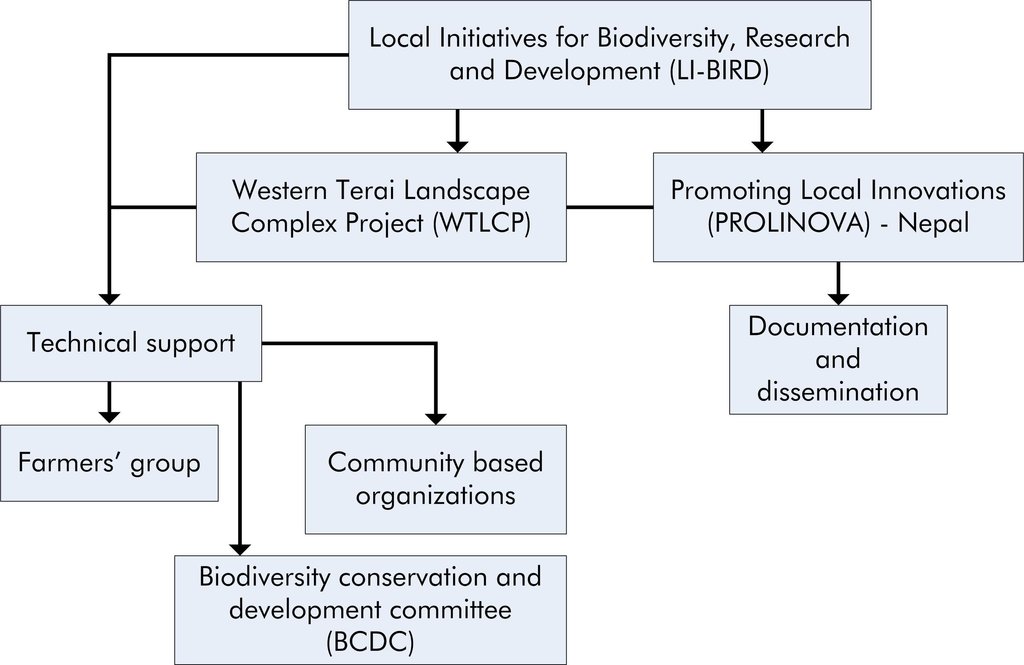Learning about no-till methods through farmer-to-farmer dissemination [النيبال]
- تاريخ الإنشاء:
- تحديث:
- جامع المعلومات: Shreedip Sigdel
- المحرر: –
- المُراجع: Fabian Ottiger
Kisan - Kisan bichko prasal dwara khanjot nagarikana kheti garne tarika ko addhyan (Main Contributor: Krishna Lamsal, LI-BIRD)
approaches_2531 - النيبال
عرض الأقسام
توسيع الكل طي الكل1. معلومات عامة
1.2 تفاصيل الاتصال بالأشخاص الرئيسيين لمصدر المعلومات والمؤسسات المعنية بتقييم وتوثيق النهج
متخصص في الإدارة المستدامة للأراضي:
متخصص في الإدارة المستدامة للأراضي:
Lamsal Krishan
+977 61 5535357/5526834 / 9841483937 (M)
naturekrish@gmail.com / klamsal@libird.org,
Local Initiatives for Biodiversity, Research and Development (LI-BIRD)
P.O.Box 324, Gairapatan, Pokhara
النيبال
اسم المؤسسة (المؤسسات) التي سهلت توثيق/تقييم النهج (إذا كان ذلك على صلة)
ICIMOD International Centre for Integrated Mountain Development (ICIMOD) - النيبالاسم المؤسسة (المؤسسات) التي سهلت توثيق/تقييم النهج (إذا كان ذلك على صلة)
Kathmandu University (KU) - النيبالاسم المؤسسة (المؤسسات) التي سهلت توثيق/تقييم النهج (إذا كان ذلك على صلة)
Local Initiatives for Biodiversity, Research, and Development (LI-BIRD) - النيبال1.3 الشروط المتعلقة باستخدام البيانات الموثقة من خلال WOCAT
متى تم تجميع البيانات (ميدانيا)؟:
01/03/2013
يوافق جامع المعلومات والشخص (لاشخاص) الرئيسي لمصدر المعلومات على الشروط المتعلقة باستخدام البيانات الموثقة من خلال WOCAT:
نعم
1.4 المراجع الخاصة باستبيان(استبيانات) تقنيات الإدارة المستدامة للأراضي
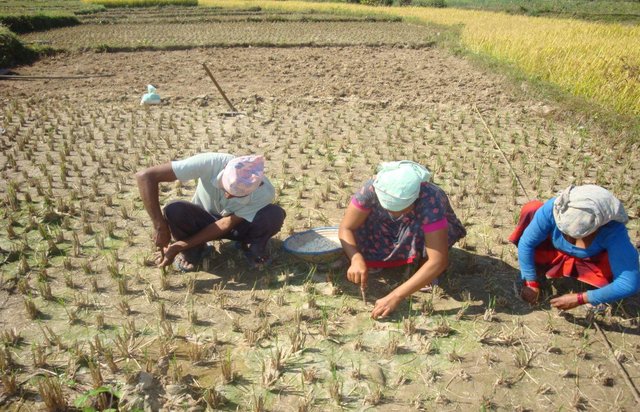
No-till garlic cultivation [النيبال]
No-till is a farming system in which the seeds are planted directly into untilled soil which still contains the previous crop residues. No-till cultivation of garlic is practiced in the tropical lowland districts of western Nepal where garlic is sown directly into the soil after the paddy is harvested.
- جامع المعلومات: Shreedip Sigdel
2. وصف نهج الإدارة المستدامة للأراضي
2.1 وصف موجز للنهج
Farmer to farmer dissemination of information on no-till methods for garlic cultivation technology
2.2 وصف تفصيلي للنهج
وصف تفصيلي للنهج:
Aims / objectives: Farmers can learn about alternative or newer methods by sharing their experiences with one another. In this approach, farmers shared information and knowledge on no-till garlic cultivation technology.
Methods: Since no-till methods are not widely known in the area, the approach aimed to increase awareness of the many features of the technique and its benefits. Through farmer-to-farmer dissemination, communities can learn about the various aspects of no-till for crop residue management, resource use, and how it can reduce labour costs. These discussions highlight the environmental and social benefits of no-till methods especially with respect to moisture retention, soil and water conservation, and climate change adaptation.
In 2009, Local Initiatives for Biodiversity, Research, and Development (LI-BIRD), piloted and validated no-till farming in Nepal as a measure for soil and water conservation through the Western Terai Landscape Complex Project (WTLCP) and the Promoting Local Innovation (PROLINNOVA) programme. The dissemination was multi-faceted and the farmers remained engaged throughout the discussions, which included both talks and group participation. Farmers’ groups, community-based organizations, biodiversity conservation groups, and development committees at the village level were given training and technical inputs. This community-level interaction encouraged farmers to discuss with one another as well as to head out to the field for demonstrations and observations. After no-till garlic cultivation was successfully piloted, it was widely adopted by farming communities and especially the indigenous Tharu communities of western Nepal.
2.3 صور عن النهج
2.5 البلد/المنطقة/المواقع التي تم تطبيق النهج فيها
البلد:
النيبال
مزيد من التفاصيل حول الموقع:
Gadariya VDC, Kailali District
2.6 تواريخ بدء وإنهاء تنفيذ النهج
أشر إلى سنة البدء:
10
2.7 نوع النهج
- مبادرة محلية حديثة/مبتكرة
2.8 الغايات/الأهداف الرئيسية للنهج
The Approach focused mainly on SLM with other activities (agricultural and livelihood related technology)
• To disseminate information and know-how on no-till methods
• To increase awareness among the farmers on the benefits of no-till methods and crop residue management
• To increase awareness of the environmental and social benefits of no-till methods and the role that it can play in adaptation to climate change
The SLM Approach addressed the following problems: • Lack of awareness about low cost soil and water conservation technologies that address farmers' needs
• Initially there was weak institutional support for organizing discussion sessions
2.9 الظروف التي تمكن أو تعيق تنفيذ التقنية/التقنيات المطبقة بموجب النهج
المعايير والقيم الاجتماعية /الثقافية/ الدينية
- معيق
No-till methods are not widely known in the area
Treatment through the SLM Approach: The group was readily convinced of the economic benefits of no-till methods (especially for garlic production) and this was essential in persuading them to accept the technology.
توفر/الوصول إلى الموارد والخدمات المالية
- معيق
Financial resources lacking; this group does not have links to financial institutions.
Treatment through the SLM Approach: Farmers used their own resources
غير ذلك
- معيق
Water availability is poor.
Treatment through the SLM Approach: No-till methods help to conserve moisture in the soil.
3. المشاركة وأدوار الأطراف المعنية
3.1 أصحاب المصلحة المعنيون بالنهج وأدوارهم
- مستخدمو الأراضي المحليون/المجتمعات المحلية
Community based organization, farmers group
About 60% of those who attend meetings are women. Most of the field activities such as planting and harvesting are performed by women. The indigenous Tharu communities are adopting this technology.
- منظمة غير حكومية
LI-BIRD
3.2 انخراط مستخدمي الأراضي المحليين/المجتمعات المحلية في المراحل المختلفة للنهج
| انخراط مستخدمي الأراضي المحليين/المجتمعات المحلية | حدد من شارك وصف الأنشطة | |
|---|---|---|
| المبادرة/التحفيز | التعبئة الذاتية | Community meetings organized to discuss the new technology and how it could be implemented locally |
| التخطيط | تفاعلي | Interactive discussion groups and focal groups organized in the community |
| التنفيذ | التعبئة الذاتية | Individual farmers implemented the technology on their land without external support. LI-BIRD provided in-kind and technical information and support. |
| الرصد/التقييم | التعبئة الذاتية | LI-BIRD monitored the implementation of the technology and helped to evaluate the outcome. They collected and analysed data in order to highlight the soil and water conservation aspects of the no-till method and disseminated this information. |
| Research | غير موجود |
3.3 مخطط التدفق (إذا كان متاحًا)
الوصف:
LI-BIRD piloted and validated no-till farming in Nepal as a measure for soil and water conservation through the Western Terai Landscape Complex Project (WTLCP) and the Promoting Local Innovation (PROLINNOVA) programme. Technical support was extended to farmers’ groups, community-based organizations, biodiversity conservation groups, and development committees at the village level.
المؤلف:
(A. K. Thaku)
3.4 اتخاذ القرار بشأن اختيار تقنية/تقنيات الإدارة المستدامة للأراضي
حدد من الذي قرر اختيار التقنية/التقنيات التي سيتم تنفيذها:
- مستخدمو الأراضي بشكل أساسي، بدعم من متخصصي الإدارة المستدامة للأراضي
اشرح:
Decisions on the method of implementing the SLM Technology were made by mainly by land users supported by SLM specialists
4. الدعم الفني وبناء القدرات وإدارة المعرفة
4.1 بناء القدرات/التدريب
هل تم تقديم التدريب لمستخدمي الأراضي / الأطراف المعنيين الآخرين؟:
نعم
حدد من تم تدريبه:
- مستخدمو الأراضي
إذا كان ذلك على صلة، حدد الجنس والعمر والوضع والعرق وما إلى ذلك.
Land users and community mobilizers from the indigenous Tharu communities were given training on no-till method and crop residue management.
شكل التدريب:
- مناطق العرض
شكل التدريب:
- Participatory methods and approaches
4.2 خدمة استشارية
هل يملك مستخدمو الأراضي وصولا إلى خدمة استشارية؟:
نعم
حدد ما إذا كانت الخدمة الاستشارية متوفرة:
- في مراكز دائمة
وصف/تعليقات:
Name of method used for advisory service: Capacity building training; Key elements: Capacity building took place through site visits and extension materials as well as through discussions and exchanges
4.3 تعزيز المؤسسات (التطوير التنظيمي)
هل تم إنشاء أو تعزيز مؤسسات من خلال هذا النهج؟:
- نعم، باعتدال
حدد المستوى (المستويات) التي تم فيها تعزيز أو إنشاء المؤسسات:
- محلي
حدد نوع الدعم:
- بناء القدرات/التدريب
- Technical support
اعط مزيدا من التفاصيل:
LI-BIRD supported farmers groups, biodiversity conservation and development committees, and community-based organizations by providing hands-on training and technical support.
4.4 الرصد والتقييم
هل يشكل الرصد والتقييم جزءا من النهج؟:
نعم
التعليقات:
technical aspects were regular monitored by project staff, government, land users through observations; indicators: Regular observations by technical staff from LI-BIRD jointly with representatives from biodiversity conservation and development committees, farmers groups, and community-based organizations
socio-cultural aspects were regular monitored by project staff, land users through observations; indicators: Regular observations by technical staff from LI-BIRD jointly with representatives from biodiversity conservation and development committees, farmers groups, and community-based organizations
economic / production aspects were regular monitored by project staff, government, land users through observations
economic / production aspects were monitored by None through measurement
There were several changes in the Approach as a result of monitoring and evaluation: Several changes were observed. People learned both through discussions and by taking a hands-on approach. An initial attempt to replicate the method ended in failure. However, through discussions and technical inputs, the farmers were eventually able to replicate the method and it is now well understood.
5. التمويل والدعم المادي الخارجي
5.1 الميزانية السنوية لمكون الإدارة المستدامة للأراضي في النهج المذكور
التعليقات (على سبيل المثال المصادر الرئيسية للتمويل/الجهات المانحة الرئيسية):
Approach costs were met by the following donors: local community / land user(s) (Mostly by the land users; capacity building activities and field demonstration costs were borne by LI-BIRD.): 100.0%
5.2 الدعم المالي/المادي المقدم لمستخدمي الأراضي
هل حصل مستخدمو الأراضي على دعم مالي/ مادي لتنفيذ التقنية/ التقنيات؟:
كلا
5.3 إعانات لمدخلات محددة (بما في ذلك العمالة)
- غير موجود
5.4 الائتمان
هل تم توفير ائتمان في إطار نهج أنشطة الإدارة المستدامة للأراضي؟:
كلا
6. تحليل الأثر والتصريحات الختامية
6.1 آثار النهج
هل ساعد النهج مستخدمي الأراضي على تنفيذ وصيانة تقنيات الإدارة المستدامة للأراضي؟:
- لا
- نعم، قليلا
- نعم، باعتدال
- نعم، إلى حد كبير
No-till and better use of crop residues has contributed to improved land management; more moisture is now retained in the soil. Water is in poor supply and vegetable production in this area is limited by the amount of moisture in the soil.
هل ساهم النهج في تمكين الفئات المحرومة اجتماعيا واقتصاديا؟:
- لا
- نعم، قليلا
- نعم، باعتدال
- نعم، إلى حد كبير
The indigenous Tharu communities now have some increased cash income from selling their garlic crop.
Did other land users / projects adopt the Approach?
- لا
- نعم، قليلا
- نعم، باعتدال
- نعم، إلى حد كبير
Community-based organizations, as well as members of other communities and neighbouring districts, have either adopted the method or expressed an interest in learning how to implement it.
Did the Approach lead to improved livelihoods / human well-being?
- لا
- نعم، قليلا
- نعم، باعتدال
- نعم، إلى حد كبير
Mainly due to increased income from garlic production and reduced labour costs associated with no-till.
Did the Approach help to alleviate poverty?
- لا
- نعم، قليلا
- نعم، باعتدال
- نعم، إلى حد كبير
mainly due to increased income from garlic production and reduced labour costs. Studies showed a 25% increase in crop yield and reduced labour requirements.
6.2 المحفز الرئيسي لقيام مستخدمي الأراضي بتنفيذ الإدارة المستدامة للأراضي
- زيادة الربح (القدرة)، وتحسين نسبة التكلفة إلى العائد
- انخفاض عبء العمل
- well-being and livelihoods improvement
6.3 استدامة أنشطة النهج
هل يمكن لمستخدمي الأراضي المحافظة على استدامة ما تم تنفيذه من خلال النهج (بدون دعم خارجي)؟:
- نعم
إذا كانت الإجابة بنعم، صف كيف:
This technology has a high probability of being sustainable because it is cost effective and requires minimal technical input (farmers can do it on their own); moreover, it helps with soil conservation.
6.4 نقاط قوة/مزايا النهج
| نقاط القوة/ المزايا/ الفرص من وجهة نظر جامع المعلومات أو غيره من الاشخاص الرئيسيين لمصدر المعلومات |
|---|
| Farmers can easily learn no-till techniques through community participation. The approach is sustainable because it is easy to implement and it appeals to farmers because they appreciate it as a way of reducing labour and increasing crop yields. (How to sustain/ enhance this strength: Continue to give some minor technical support and encouragement.) |
| The approach focused on building capacity by using a hands-on approach similar to how farmers traditionally transfer know-how between themselves. Farmers can adapt and modify the technology as needed to deal with changing conditions in the environment. Financial inputs by external organizations are not needed. (How to sustain/ enhance this strength: Continue to give some minor technical support and encouragement.) |
6.5 نقاط الضعف/ العيوب في المنهج وطرق التغلب عليها
| نقاط الضعف/ المساوىء/ المخاطر من وجهة نظر جامع المعلومات أو غيره من الاشخاص الرئيسيين لمصدر المعلومات | كيف يمكن التغلب عليها؟ |
|---|---|
| Market linkages are poor and the scope to scale up is also small. | The establishment of stronger market linkages would motivate farmers to attempt commercial cultivation. |
7. المراجع والروابط
7.1 طرق جمع/مصادر المعلومات
- زيارات ميدانية، مسوحات ميدانية
- مقابلات مع مستخدمي الأراضي
الروابط والوحدات المواضيعية
توسيع الكل طي الكلالروابط

No-till garlic cultivation [النيبال]
No-till is a farming system in which the seeds are planted directly into untilled soil which still contains the previous crop residues. No-till cultivation of garlic is practiced in the tropical lowland districts of western Nepal where garlic is sown directly into the soil after the paddy is harvested.
- جامع المعلومات: Shreedip Sigdel
الوحدات المواضيعية
لا يوجد وحدات مواضيعية


